The custom gym wear manufacturing industry offers exciting opportunities for fitness brands, personal trainers, and gym owners who want to create unique athletic apparel that stands out in a crowded market.
This complete guide is designed for entrepreneurs launching fitness clothing lines, established brands expanding their product range, and gym owners looking to create branded merchandise for their members. We'll walk you through every step of bringing your custom gym wear vision to life.
You'll discover how to navigate essential design considerations that balance style with performance, ensuring your activewear meets the demands of serious athletes. We'll also cover how to choose the right manufacturing partner who can deliver quality products on time and within budget. Finally, you'll learn about effective shipping and delivery logistics management to get your custom gym wear from production floor to customer door smoothly.
From initial concept sketches to final product delivery, this guide provides practical insights to help you build a successful custom gym wear business.
Understanding the Custom Gym Wear Manufacturing Market
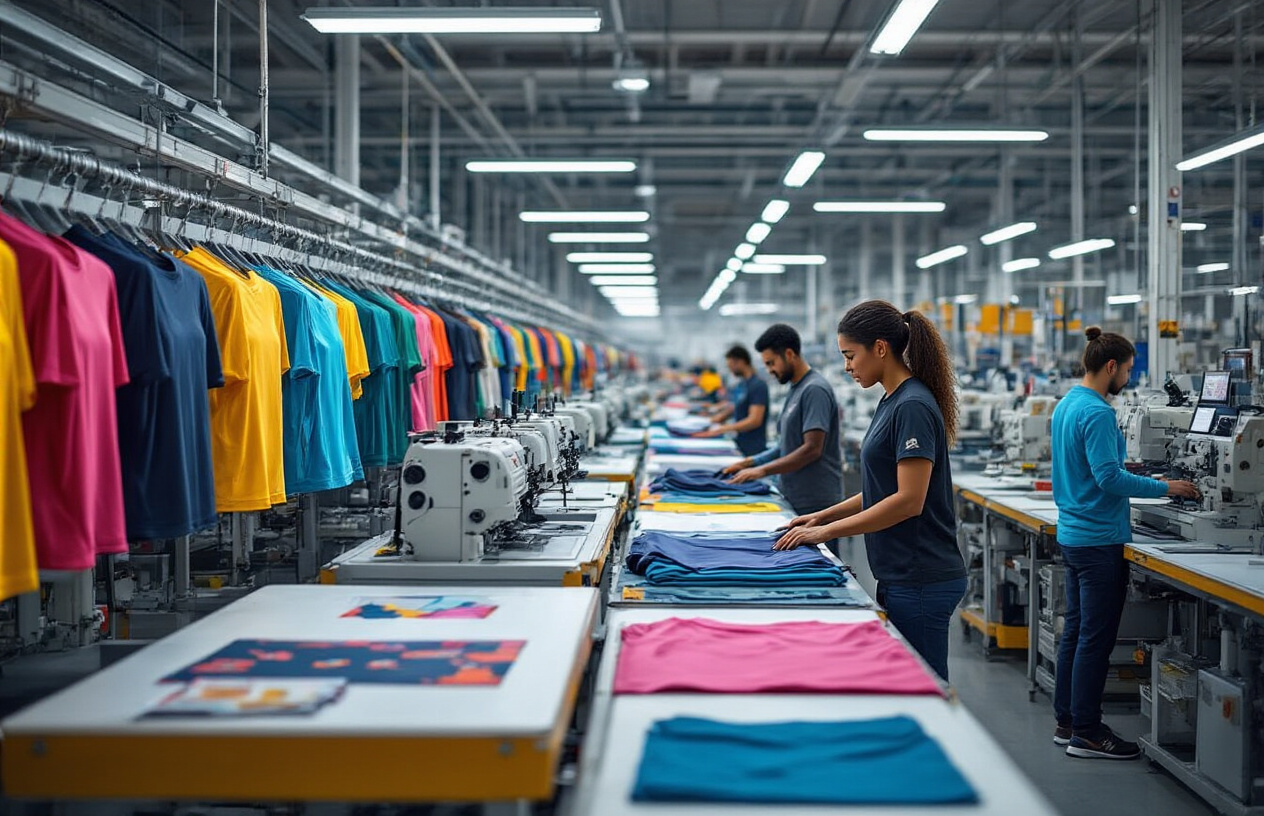
Market size and growth opportunities in fitness apparel
The global fitness apparel market has exploded into a multi-billion dollar industry, with custom gym wear representing one of the fastest-growing segments. Recent industry reports value the activewear market at over $350 billion, with custom and personalized segments experiencing annual growth rates of 12-15%, significantly outpacing traditional sportswear.
Several factors drive this remarkable expansion. The rise of boutique fitness studios, CrossFit boxes, and specialized training facilities creates constant demand for unique branded apparel. Corporate wellness programs increasingly invest in custom workout gear for employees, while sports teams at all levels seek distinctive uniforms that reflect their identity.
The athleisure trend has expanded the market beyond traditional gym settings. People now wear workout clothes to coffee shops, grocery stores, and casual social gatherings, creating opportunities for fashion-forward custom designs that transition seamlessly from gym to street.
E-commerce platforms have democratized access to custom manufacturing, allowing small businesses and individual entrepreneurs to enter the market with minimal upfront investment. Print-on-demand services and low minimum order quantities have lowered barriers to entry while maintaining healthy profit margins.
Key differences between custom and mass-produced activewear
Custom gym wear operates on fundamentally different principles than mass-produced alternatives. Mass production focuses on broad appeal, standardized sizing, and economies of scale, while custom manufacturing prioritizes personalization, unique branding, and specialized fit requirements.
Quality control differs significantly between approaches. Custom manufacturers typically produce smaller batches with greater attention to detail, allowing for higher-quality construction and premium materials. Mass producers optimize for cost efficiency, sometimes compromising on fabric quality or construction methods to meet aggressive price points.
Lead times present another major distinction. Custom orders require design approval, sample creation, and production scheduling, typically taking 2-6 weeks compared to immediate availability of mass-produced items. However, custom pieces offer exclusive designs that competitors cannot replicate.
Pricing structures vary dramatically. Custom gym wear commands premium prices due to personalization, lower production volumes, and specialized manufacturing processes. Mass-produced items benefit from bulk purchasing power and streamlined production but compete in saturated markets with thin margins.
| Aspect | Custom Gym Wear | Mass-Produced |
|---|---|---|
| Design flexibility | Complete customization | Limited options |
| Minimum orders | 25-100 pieces | Immediate single units |
| Lead time | 2-6 weeks | Immediate |
| Price point | Premium | Budget to mid-range |
| Market saturation | Low competition | High competition |
Target demographics and their specific needs
Custom gym wear attracts diverse demographic segments, each with distinct requirements and purchasing behaviors. Fitness studios and gyms represent the largest customer base, seeking branded apparel that builds community identity and generates additional revenue streams. These businesses prioritize moisture-wicking fabrics, durability, and professional appearance.
Corporate clients constitute a rapidly growing segment. Companies ordering custom activewear for employee wellness programs, team-building events, or company-sponsored races value comfort, professional aesthetics, and clear branding opportunities. They typically place larger orders and maintain ongoing relationships with manufacturers.
Sports teams from youth leagues to semi-professional organizations need performance-oriented custom gear. Their priorities include team colors, player names and numbers, sponsor logos, and fabrics that perform under competitive conditions. This segment values both functionality and team unity through matching designs.
Individual entrepreneurs and influencers represent an emerging market segment. These customers launch activewear lines with minimal inventory investment, testing market response before scaling production. They need flexible minimum orders, trendy designs, and quick turnaround times to capitalize on social media trends.
Specialty fitness communities like yoga studios, dance groups, or martial arts schools seek apparel that reflects their unique culture and values. They often prefer eco-friendly materials, specific fit requirements for their activities, and designs that represent their philosophical approaches to fitness.
Profit margins and business potential
Custom gym wear manufacturing offers attractive profit margins significantly higher than mass-produced alternatives. Typical gross margins range from 45-65%, depending on design complexity, material choices, and order volumes. Premium custom pieces can achieve even higher margins when targeting affluent demographics or specialized markets.
The business model scales effectively across different market segments. Small orders for local gyms might generate $500-2,000 per project, while corporate contracts can reach $10,000-50,000 for single orders. Successful manufacturers often develop recurring relationships, creating predictable revenue streams through repeat business and referrals.
Investment requirements remain relatively modest compared to other manufacturing ventures. Many successful custom gym wear businesses start with $10,000-25,000 in initial capital, focusing on design capabilities and supplier relationships rather than expensive equipment. Drop-shipping and print-on-demand models reduce inventory risks while maintaining healthy margins.
Market positioning significantly impacts profitability. Manufacturers focusing on premium segments command higher prices through superior materials, construction quality, and design services. Those targeting budget-conscious customers compete primarily on price, resulting in thinner margins but potentially higher volumes.
Geographic expansion opportunities continue growing as fitness culture spreads globally. International markets often lack established custom activewear suppliers, creating opportunities for experienced manufacturers to capture first-mover advantages in emerging regions.
Essential Design Considerations for Custom Gym Wear
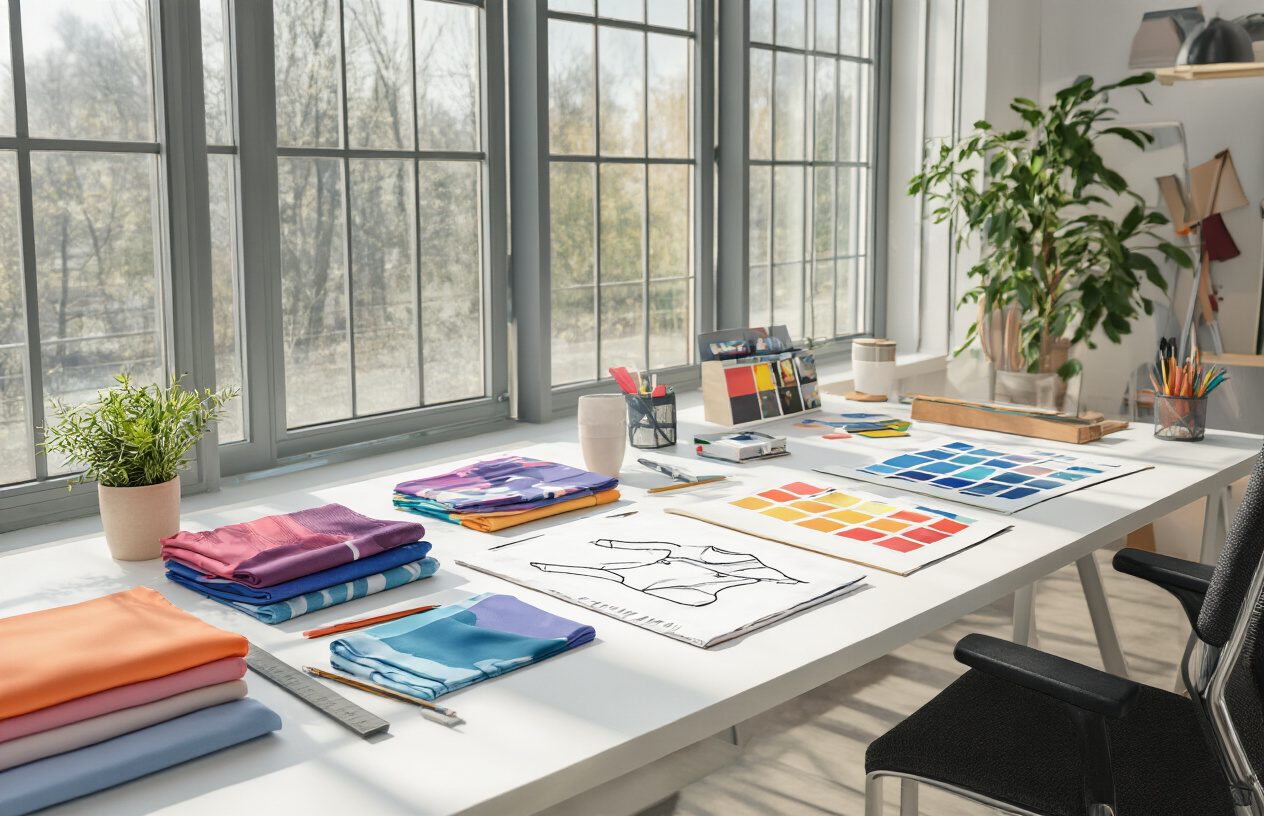
Performance Fabric Selection for Different Workout Types
The foundation of any successful custom gym wear line lies in choosing the right fabrics for specific workout activities. High-intensity interval training demands moisture-wicking polyester blends with four-way stretch capabilities, allowing athletes to move freely while staying dry during explosive movements. These fabrics typically feature mesh panels or perforated zones in high-sweat areas like the back and underarms.
For yoga and Pilates enthusiasts, buttery-soft nylon-spandex blends reign supreme. These fabrics offer exceptional stretch recovery and compression without feeling restrictive during deep stretches or inverted poses. The smooth texture prevents chafing during floor work, while the opacity ensures confidence in various positions.
Weightlifting apparel requires durable, thick fabrics that can withstand the friction of barbells and equipment. Cotton-polyester blends work well here, offering comfort and breathability while maintaining structure. Reinforced seams and abrasion-resistant materials in contact zones extend garment lifespan significantly.
Running gear benefits from lightweight, technical fabrics with moisture management properties. Polyester microfiber blends with silver ion treatments provide antimicrobial benefits for long training sessions. Reflective threading integration enhances safety during early morning or evening runs.
| Workout Type | Ideal Fabric | Key Properties |
|---|---|---|
| HIIT/CrossFit | Polyester-spandex blend | Moisture-wicking, 4-way stretch |
| Yoga/Pilates | Nylon-spandex blend | Soft hand feel, compression |
| Weightlifting | Cotton-poly blend | Durability, structure |
| Running | Technical polyester | Lightweight, antimicrobial |
Ergonomic Fit and Movement-Friendly Construction
Creating gym wear that moves with the body requires understanding human biomechanics and stress points during exercise. Flat-lock seams prevent chafing and skin irritation, particularly important in areas where fabric meets skin repeatedly during movement. These specialized seams lie flat against the body instead of creating raised ridges.
Gussets play a crucial role in enhancing mobility. Diamond-shaped gussets in the crotch area of leggings allow for deep squats and lunges without fabric strain. Similarly, underarm gussets in tops accommodate overhead movements without pulling or restricting circulation.
Strategic paneling creates shape while maintaining stretch. Side panels in leggings provide a flattering silhouette while allowing the front and back panels to maintain their technical properties. Color-blocking isn't just aesthetic—it serves functional purposes by placing different fabric types where they're most needed.
Waistband construction significantly impacts comfort and performance. Wide waistbands distribute pressure evenly, preventing rolling and digging during core exercises. Internal drawstrings provide adjustability without external bulk, while silicone grip strips keep garments in place during intense movement.
Pattern grading for activewear differs from street wear. Extra ease through the shoulders and hips accommodates the expanded range of motion required during exercise, while maintaining a close fit that doesn't impede performance.
Aesthetic Trends and Customization Options
Current gym wear trends blend performance with street style, creating versatile pieces that transition seamlessly from workout to errands. Color palettes shift seasonally, with earth tones and jewel colors dominating recent collections. Customers increasingly seek unique colorways that stand out in crowded gym environments.
Sublimation printing opens unlimited design possibilities, allowing for photographic-quality prints that won't fade, crack, or peel. This technique works best on polyester fabrics and enables everything from marble textures to galaxy prints. Screen printing remains popular for bold logos and text, offering durability and vibrant colors on various fabric types.
Heat transfer vinyl provides crisp, professional-looking customization for small quantities. This method works well for names, numbers, and simple graphics. Embroidery adds a premium touch to custom orders, particularly effective for brand logos and monograms on caps and jackets.
Cut-and-sew customization allows for completely unique designs. Customers can specify panel colors, contrast stitching, and custom fits. This approach requires longer lead times but delivers truly personalized products that can't be found elsewhere.
Digital printing technology enables on-demand customization, reducing minimum order quantities and allowing for personalized designs. Quick turnaround times make this option attractive for teams needing uniforms fast.
Size Inclusivity and Diverse Body Type Accommodation
Modern custom gym wear manufacturing must address the full spectrum of body types and sizes. Extended size ranges from XS to 4XL+ ensure everyone can find properly fitting activewear. This requires developing separate pattern blocks for plus sizes rather than simply scaling up smaller sizes, as body proportions change significantly across size ranges.
Fit models representing diverse body types improve pattern accuracy across all sizes. Using models with different heights, torso lengths, and proportions during development ensures garments fit well on real bodies, not just idealized forms. Plus-size fit models help identify specific construction details needed for larger sizes, such as reinforced seams and additional support features.
Adaptive design features accommodate various physical abilities and needs. Side zippers make dressing easier for those with limited mobility, while magnetic closures provide alternatives to traditional fastenings. These features benefit all users while specifically addressing accessibility needs.
Maternity activewear represents a growing market segment requiring specialized construction. Empire waistlines, side ruching, and expandable panels accommodate changing body shapes throughout pregnancy. Nursing-friendly designs with discreet access points serve new mothers returning to fitness.
Adjustable features enhance fit across body types. Removable bra cups allow customization for different bust sizes and support preferences. Adjustable straps and multiple closure points provide personalized fits that accommodate body changes over time.
Cultural considerations influence design decisions for global markets. Modest activewear with longer hemlines and higher necklines serves specific communities while maintaining performance properties. Understanding these needs expands market reach and demonstrates inclusive business practices.
Choosing the Right Manufacturing Partner

Evaluating Production Capabilities and Quality Standards
Finding a manufacturing partner starts with understanding what they can actually deliver. Look at their equipment first - modern knitting machines, cutting technology, and finishing equipment directly impact the quality of your final product. A manufacturer working with outdated machinery will struggle to produce the technical fabrics and precision fits that today's gym wear demands.
Request samples of similar products they've manufactured. Pay attention to stitching quality, fabric hand-feel, and construction details like flatlock seams and reinforced stress points. The best manufacturers will showcase their range of technical capabilities, from moisture-wicking treatments to four-way stretch construction.
Certifications matter more than you might think. Look for ISO 9001 quality management systems, OEKO-TEX fabric standards, and WRAP social compliance certifications. These aren't just fancy certificates on the wall - they represent systematic approaches to quality control and ethical manufacturing practices.
Visit their facility if possible. A well-organized factory with proper quality control stations and skilled workers will be evident immediately. Watch how they handle fabric inspection, cutting accuracy, and final garment inspection. Quality manufacturers will have dedicated QC teams at multiple production stages.
Ask about their testing capabilities. Can they perform fabric strength tests, colorfastness evaluations, and wash durability assessments? Manufacturers who invest in testing equipment take quality seriously and can catch problems before they reach your customers.
Minimum Order Quantities and Pricing Structures
MOQs vary dramatically across manufacturers and directly impact your business model. Smaller operations might accept orders of 100-200 pieces per style and colorway, while larger factories often require 500-1000+ pieces. Don't just focus on the total quantity - understand per-style and per-color minimums, as these can multiply quickly across different sizes and designs.
Pricing structures get complicated fast. Beyond the base garment cost, factor in sampling fees, artwork setup charges, custom label costs, and packaging expenses. Some manufacturers include basic hangtags and polybags, while others charge extra for everything. Get detailed breakdowns to avoid surprises.
Volume-based pricing tiers reward larger orders, but the jumps between tiers vary significantly. A manufacturer might offer 10% discounts at 500 pieces and another 5% at 1000 pieces, while others have more gradual reductions. Calculate your actual cost per piece across different order sizes to find your sweet spot.
Payment terms affect your cash flow planning. Standard arrangements include 30-50% deposits with balance due before shipping. Some manufacturers offer better terms for repeat customers or larger orders. International suppliers often require letters of credit for first-time buyers, adding banking fees to your costs.
Hidden costs can destroy your margins. Shipping samples, additional fittings, rush orders, and design modifications all carry charges. Ask upfront about revision fees, extra sampling costs, and expedited production surcharges. Transparent manufacturers will provide comprehensive cost breakdowns.
Communication and Collaboration Processes
Clear communication channels make or break manufacturing relationships. Establish primary contacts on both sides and understand their availability across time zones. Many overseas manufacturers assign dedicated project managers for larger accounts, while smaller operations might have you working directly with production managers or owners.
Response times vary widely between manufacturers. Some respond within hours during business days, others take 24-48 hours. Set expectations upfront about communication frequency, especially during critical production phases. Weekly progress updates during production help catch issues early.
Language barriers create more problems than most people anticipate. Technical garment terminology, specific quality requirements, and design details can get lost in translation. Work with manufacturers who have English-speaking staff or reliable translation support. Detailed tech packs with clear illustrations reduce miscommunication significantly.
Project management tools streamline collaboration. Manufacturers using systems like WhatsApp Business, Slack, or dedicated platforms provide better visibility into order status, sample approvals, and production timelines. Some offer online portals where you can track progress and approve samples digitally.
Design collaboration capabilities separate good manufacturers from great ones. Can they provide technical input on your designs? Do they suggest improvements for manufacturability or cost reduction? The best partners become extensions of your design team, offering expertise on fabric selection, construction methods, and market trends.
Documentation standards protect both parties. Professional manufacturers provide detailed quotations, clear sampling timelines, and comprehensive production schedules. They confirm all design changes in writing and provide photo updates during key production milestones.
Product Development and Prototyping Process
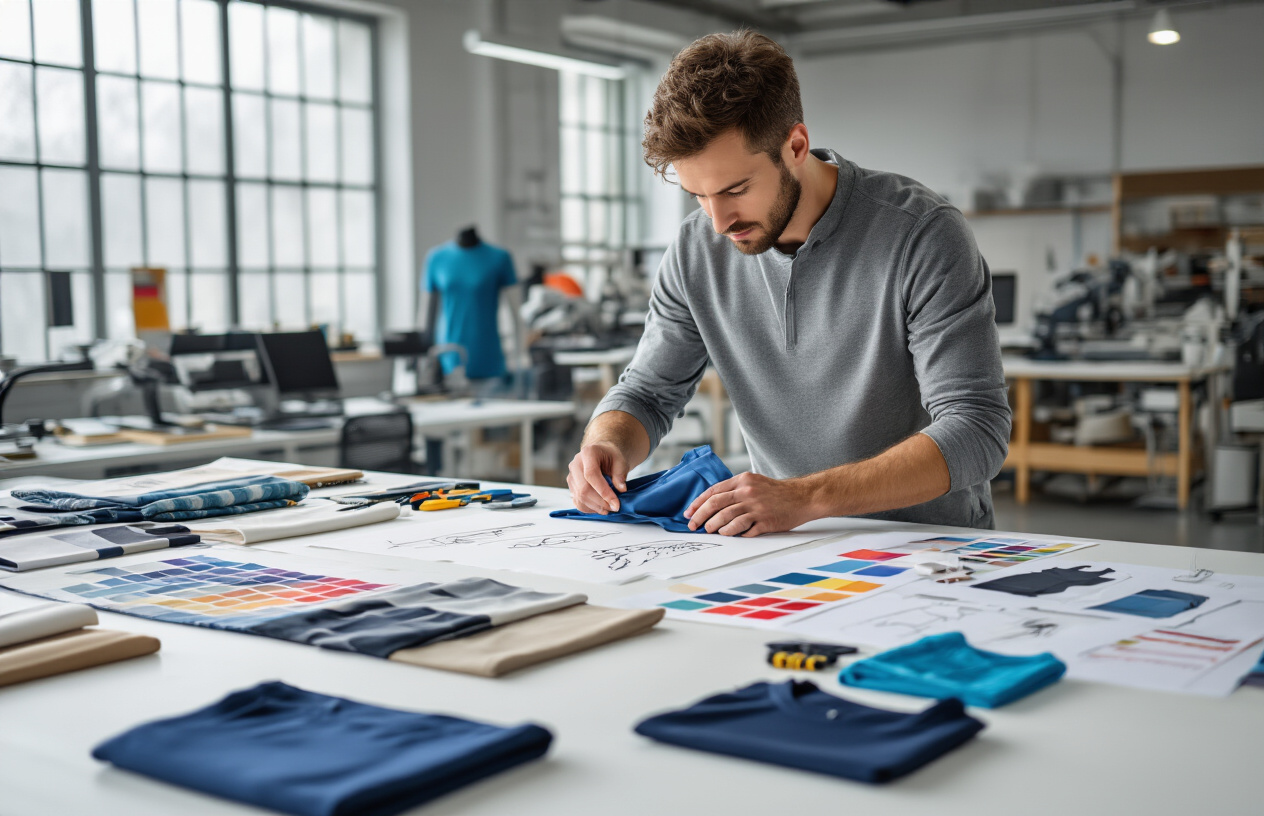
Technical Specification Creation and Material Sourcing
Creating detailed technical specifications serves as the foundation for successful custom gym wear manufacturing. Start by documenting precise measurements, including chest, waist, hip, sleeve length, and inseam dimensions across all intended sizes. Include specific details about seam placement, stitching requirements, and construction methods that will ensure durability during intense workouts.
Material sourcing requires careful consideration of performance characteristics. Moisture-wicking fabrics like polyester blends or bamboo fiber work well for high-intensity activities, while cotton-poly blends offer comfort for casual wear. Research fabric weights, typically measured in GSM (grams per square meter), to match the intended use - lighter weights (120-150 GSM) for summer activewear and heavier weights (180-220 GSM) for cooler climates.
Establish clear specifications for additional components including zippers, elastic bands, drawstrings, and hardware. Document thread colors, label placement requirements, and any special finishes like anti-microbial treatments or UV protection. Create comprehensive tech packs that include flat sketches, construction details, and colorways to communicate your vision effectively to manufacturers.
Sample Production and Fit Testing Procedures
Sample production begins with creating initial prototypes based on your technical specifications. Request samples in multiple sizes to evaluate fit across your target size range. The first round typically focuses on basic construction and proportions rather than final details.
Conduct thorough fit testing using real people who represent your target customers. Have testers perform typical gym movements - squats, lunges, arm raises, and stretching - while wearing the samples. Document any areas where fabric pulls, restricts movement, or feels uncomfortable. Pay special attention to stress points like crotch seams, armholes, and waistbands.
Test fabric performance under actual workout conditions. Evaluate how materials respond to sweat, stretching, and repeated washing. Check for color bleeding, shrinkage, and fabric integrity after multiple wash cycles. Document these findings with photos and detailed notes to guide revisions.
Create a standardized feedback form covering fit, comfort, durability, and aesthetic appeal. Use numerical rating systems alongside written comments to quantify improvements needed between sample iterations.
Quality Control Checkpoints and Approval Stages
Implement a multi-stage approval process with clear checkpoints at each development phase. The first checkpoint occurs after initial technical specifications are complete but before sample production begins. Review all measurements, materials, and construction details with your manufacturing partner to catch potential issues early.
Set up a formal sample approval process with specific criteria for each round. First samples focus on fit and basic construction. Second samples address initial feedback and include correct colors, trims, and finishes. Final samples should be production-ready with all details perfected.
Document quality standards for stitching, finishing, and overall construction. Specify acceptable tolerances for measurements, color matching, and defect rates. Create inspection checklists covering seam strength, fabric quality, print durability, and overall workmanship.
Establish approval authority levels - determine who can approve minor changes versus major revisions. Require written sign-off at each stage before proceeding to prevent miscommunication and costly errors later in the process.
Timeline Management for Efficient Development
Effective timeline management starts with realistic expectations about development duration. Initial design and specification creation typically takes 1-2 weeks, while sample production and testing can require 3-4 weeks per round. Plan for 2-3 sample rounds minimum, adding extra time for complex designs or new material testing.
Create buffer time for unexpected delays, especially when working with overseas manufacturers. Factor in shipping time for samples, potential customs delays, and time zone differences that can slow communication. Build flexibility into your schedule to accommodate revision cycles without derailing your launch timeline.
Use project management tools to track progress and maintain clear communication with your manufacturing partner. Set specific milestones with delivery dates and hold regular check-in calls to address issues promptly. Request photo updates during sample production to monitor progress and catch potential problems before samples ship.
Coordinate development timelines with your broader business needs, including marketing campaigns, seasonal sales periods, and inventory requirements. Start development well in advance of target launch dates to ensure adequate time for thorough testing and refinement without compromising quality standards.
Production Planning and Bulk Manufacturing
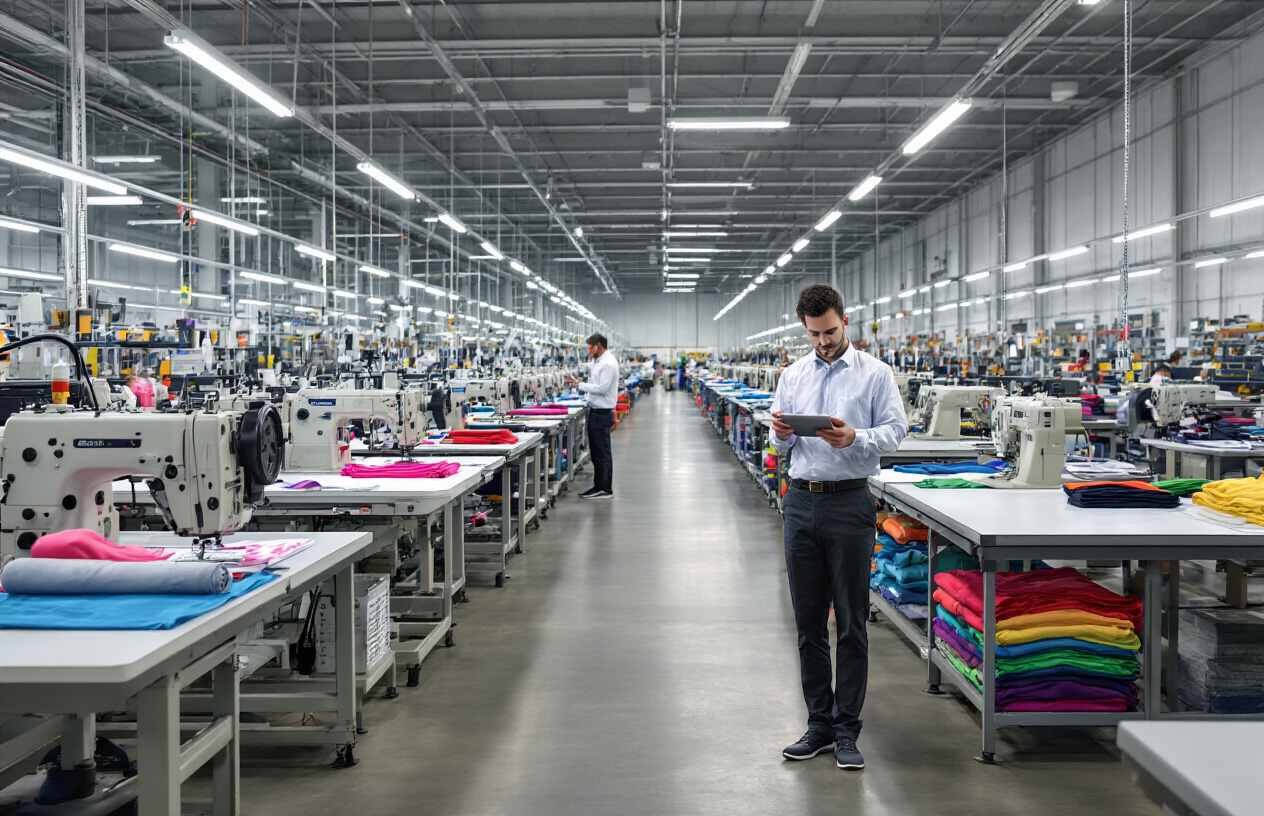
Order Processing and Production Scheduling
Effective order processing starts the moment a custom gym wear order lands in your system. Smart manufacturers implement automated workflows that capture order details, verify specifications, and flag potential issues before production begins. Digital order management systems track everything from fabric requirements to color specifications, creating a seamless handoff between sales and production teams.
Production scheduling requires balancing multiple factors: order sizes, delivery deadlines, machine capacity, and labor availability. Master schedulers typically work with 4-6 week production windows, allowing buffer time for unexpected delays. They prioritize orders based on delivery dates, customer importance, and production efficiency. Large orders often get broken into smaller batches to maintain quality control and meet interim deadlines.
Modern manufacturers use production planning software that visualizes capacity across different workstations. This helps identify bottlenecks before they occur. For example, if embroidery capacity is limited, orders requiring intricate designs get scheduled earlier in the production cycle. Smart scheduling also considers fabric lead times, ensuring materials arrive exactly when needed to avoid storage costs and inventory buildup.
Communication becomes critical during this phase. Automated status updates keep customers informed about production milestones, while internal dashboards give production managers real-time visibility into order progress. This transparency builds trust and allows for proactive problem-solving when issues arise.
Quality Assurance During Mass Production
Quality control in bulk manufacturing goes far beyond final inspection. The most successful manufacturers build quality checkpoints throughout the entire production process, catching issues early when they're cheaper and easier to fix.
Pre-production quality starts with incoming material inspection. Every fabric roll gets checked for consistency, color matching, and defects before cutting begins. Pattern makers verify that digital designs translate correctly to physical templates, and cutting teams inspect each piece for accuracy and clean edges.
During assembly, quality control inspectors check every major milestone: seam construction, fit consistency, and logo placement. Smart manufacturers implement statistical sampling methods, inspecting predetermined percentages of each batch rather than every single piece. This approach maintains quality standards while keeping production moving efficiently.
Digital quality tracking systems document every inspection point, creating detailed quality reports for each order. When issues arise, these systems help trace problems back to their source - whether it's a specific machine, operator, or material batch. This data drives continuous improvement efforts and helps prevent recurring problems.
Final inspection covers fit, finish, and functionality. Garments undergo stretch tests, wash tests, and visual inspections under different lighting conditions. Quality teams also verify that custom specifications match original order requirements, checking everything from sizing charts to color accuracy against approved samples.
Inventory Management and Storage Solutions
Effective inventory management in custom gym wear manufacturing requires tracking materials, work-in-progress items, and finished goods simultaneously. Raw material inventory includes fabrics, threads, zippers, labels, and packaging materials. Smart manufacturers maintain safety stock levels based on historical usage patterns and supplier lead times, preventing production delays while minimizing carrying costs.
Work-in-progress tracking becomes complex with custom orders since each batch has unique specifications. Digital inventory systems tag items with order numbers, customer details, and production stages. This granular tracking prevents mix-ups and enables accurate delivery estimates. Barcode scanning at each production stage automatically updates inventory positions and triggers next-step notifications.
Storage solutions vary based on product types and order volumes. Climate-controlled warehouses protect sensitive materials like moisture-wicking fabrics and elastics. Finished goods require organized storage systems that enable quick picking and shipping. Many manufacturers use zone-based storage, grouping items by customer or delivery date to streamline fulfillment processes.
Automated inventory replenishment systems monitor usage patterns and trigger reorders when stock levels hit predetermined thresholds. These systems consider seasonal demand fluctuations, promotional activities, and new product launches. Integration with supplier systems enables just-in-time delivery for high-volume materials while maintaining buffer stocks for critical items.
Inventory accuracy directly impacts customer satisfaction and operational efficiency. Regular cycle counting and annual physical inventories verify system accuracy, while exception reports identify discrepancies requiring investigation. Mobile inventory apps enable real-time updates from the production floor, improving accuracy and reducing manual data entry errors.
Packaging and Branding for Custom Orders

Custom packaging design and material selection
Creating standout packaging for custom gym wear starts with understanding your brand's personality and your customers' expectations. The packaging becomes an extension of your brand story, making the unboxing experience memorable and Instagram-worthy. High-quality materials like rigid boxes, soft-touch laminated surfaces, or eco-friendly kraft paper can elevate the perceived value of your products significantly.
Material selection depends heavily on your target demographic and price point. Premium athletic brands often opt for sturdy cardboard boxes with magnetic closures, tissue paper, and custom stickers. Budget-conscious operations might choose poly mailers with branded designs that still look professional while keeping costs manageable. Consider texture, durability, and visual appeal when making these decisions.
Color schemes should align perfectly with your existing brand palette, while typography needs to remain consistent with your website and other marketing materials. Custom inserts, branded tape, and thank-you cards add personal touches that customers remember and share on social media platforms.
Brand consistency across all customer touchpoints
Every piece of packaging material becomes a touchpoint between your brand and customers. From the shipping label to the inner tissue paper, each element should reinforce your brand identity. This consistency builds trust and recognition, making customers more likely to reorder and recommend your products to friends.
Your logo placement, font choices, and messaging tone should match what customers see on your website, social media, and product tags. If your online presence feels modern and energetic, your packaging shouldn't feel corporate and stuffy. The disconnect confuses customers and weakens brand recognition.
Documentation included with orders – care instructions, size guides, return policies – should use the same voice and design elements. Even small details like the color of shipping labels or the style of product tags contribute to the overall brand experience. Companies that nail this consistency often see higher customer lifetime values and organic word-of-mouth marketing.
Cost-effective packaging solutions for different order sizes
Smart packaging strategies scale with order volumes while maintaining quality standards. Single-item orders might ship in custom poly mailers with branded designs, keeping shipping costs low while still looking professional. Multi-item orders could use branded boxes that accommodate various product combinations without excess space or materials.
Bulk orders to retailers require different approaches entirely. Master cartons with clear labeling systems, individual product wrapping, and efficient space utilization become priorities. Consider modular packaging systems where smaller branded boxes nest inside larger shipping containers for wholesale orders.
Volume discounts from packaging suppliers become significant as your business grows. Start with minimum order quantities that make sense for your current sales volume, but plan for growth by selecting suppliers who can scale with your needs. Some manufacturers offer tiered pricing that rewards loyalty and larger commitments.
| Order Size | Packaging Solution | Estimated Cost Per Unit |
|---|---|---|
| 1-2 items | Custom poly mailer | $0.50 - $1.00 |
| 3-5 items | Small branded box | $1.50 - $3.00 |
| 6+ items | Medium branded box | $2.50 - $4.50 |
| Bulk/Wholesale | Master carton system | $0.25 - $0.75 |
Sustainability considerations in packaging choices
Environmental responsibility resonates strongly with fitness enthusiasts who often prioritize health and wellness in all life areas. Sustainable packaging options have improved dramatically, offering performance that rivals traditional materials while reducing environmental impact.
Recycled cardboard, biodegradable poly mailers made from corn starch, and soy-based inks represent practical sustainable choices. Many suppliers now offer carbon-neutral shipping options and packaging made from post-consumer recycled content. These materials often cost slightly more upfront but can justify premium pricing and appeal to environmentally conscious consumers.
Minimalist packaging designs reduce material usage while creating clean, modern aesthetics. Right-sizing packages eliminates waste and reduces shipping costs. Reusable packaging elements like drawstring bags or storage containers add value for customers while supporting sustainability goals.
Consider offering packaging-free options for local deliveries or implementing take-back programs where customers can return packaging for reuse. These initiatives build community engagement while demonstrating genuine commitment to environmental responsibility beyond marketing messaging.
Shipping and Delivery Logistics Management
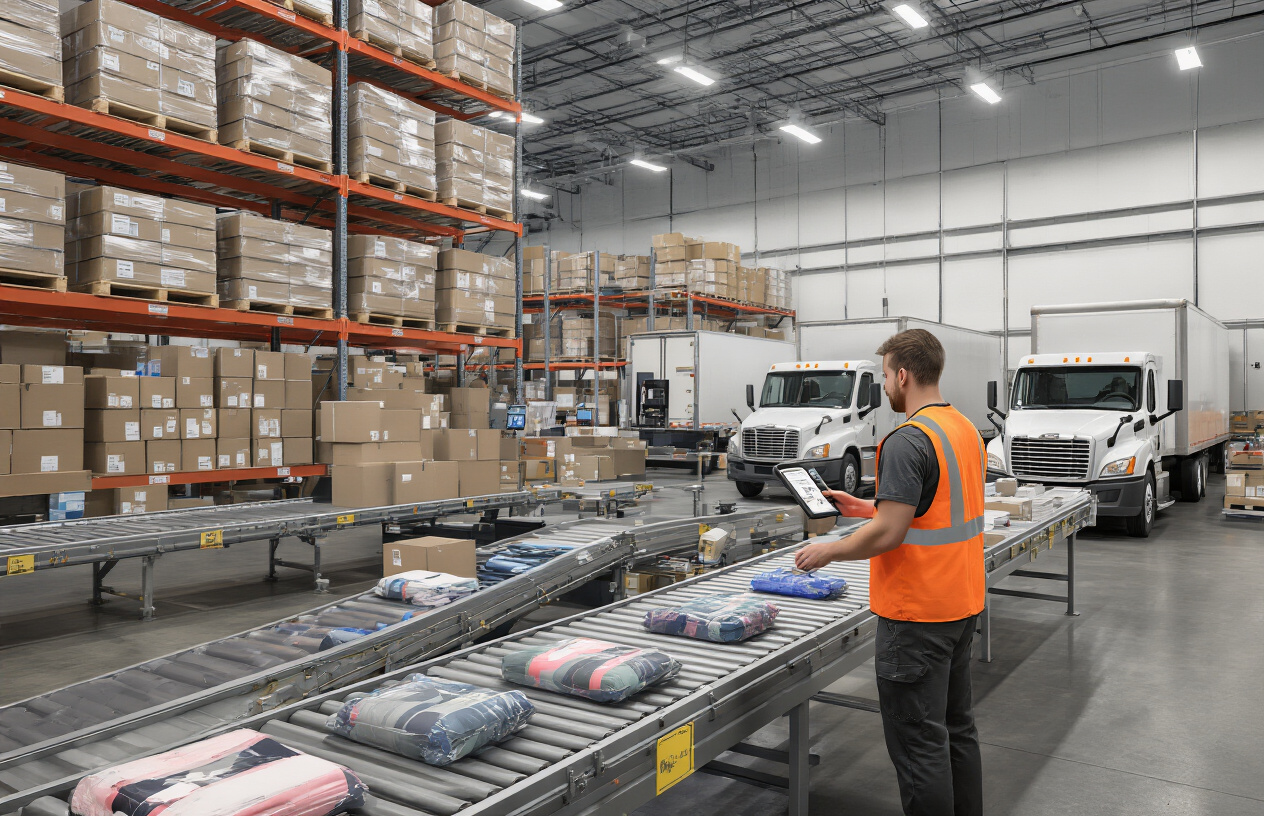
Domestic and International Shipping Options
Setting up shipping options for custom gym wear requires balancing cost, speed, and reliability. For domestic shipments, partner with multiple carriers to provide customers with choices based on their urgency and budget. Standard ground shipping through UPS, FedEx, or USPS typically takes 3-7 business days and works well for bulk orders where timing isn't critical. Express options like 2-day or overnight shipping cater to urgent orders but come with higher costs.
International shipping opens up global markets but introduces complexity. Consider partnered services like DHL Express, FedEx International, or UPS Worldwide Express for faster delivery times. For cost-conscious international customers, economy options through postal services work well, though delivery times can extend to 2-4 weeks.
Weight and dimensional pricing significantly impact shipping costs for gym wear. Lightweight moisture-wicking fabrics help keep shipping affordable, while bulky items like hoodies or multiple-piece orders may push packages into higher pricing tiers. Implement dimensional weight calculations in your shipping calculator to provide accurate rates upfront.
Free shipping thresholds encourage larger orders while protecting profit margins. Many successful custom apparel brands offer free domestic shipping on orders over $75-100, absorbing the cost as a marketing expense. For international orders, consider free shipping on larger orders ($150+) or transparent flat-rate pricing by region.
Regional fulfillment centers reduce shipping times and costs. If order volume justifies it, storing inventory in multiple locations lets you ship from the closest facility. Third-party logistics providers (3PLs) offer this capability without the overhead of managing multiple warehouses yourself.
Tracking Systems and Customer Communication
Real-time tracking builds customer confidence and reduces support inquiries. Integrate with carrier APIs to automatically pull tracking information and display it in customer accounts. Send automated tracking emails immediately when orders ship, including carrier information and estimated delivery dates.
Proactive communication prevents anxiety and builds trust. Send updates at key milestones: order confirmation, production start, quality check completion, and shipping notification. For custom orders with longer production times, weekly progress updates keep customers engaged and informed about their order status.
SMS notifications complement email updates, especially for delivery confirmations and exceptions. Many customers prefer text alerts for time-sensitive information like "out for delivery" or "delivery attempted" messages. Keep SMS messages concise and include essential information like tracking numbers and next steps.
Exception handling separates good service from great service. When packages face delays, damage, or delivery issues, notify customers immediately with specific details and resolution timelines. Automatic alerts from carrier systems can trigger these communications, but personal follow-up calls for high-value orders show extra care.
Customer portal features enhance the self-service experience. Allow customers to modify delivery addresses (when possible), schedule delivery appointments, and access detailed order history. Integration with carrier delivery management systems enables customers to redirect packages to pickup locations or reschedule deliveries directly.
Order status categories should be clear and specific: Design Review, Production Queue, In Production, Quality Control, Packaging, Shipped, and Delivered. Each status should trigger appropriate customer communications and internal workflow actions.
Return and Exchange Policy Implementation
Clear return policies protect both business interests and customer satisfaction. For custom gym wear, establish different policies for standard items versus personalized products. Non-customized items can typically be returned within 30 days in original condition, while custom-printed or embroidered pieces may have stricter limitations due to their personalized nature.
Quality-based returns require straightforward processes. Manufacturing defects, printing errors, or size discrepancies should be covered under warranty returns with no cost to customers. Establish clear photo documentation requirements for quality claims to streamline approval processes and reduce back-and-forth communication.
Return merchandise authorization (RMA) systems prevent confusion and streamline processing. Generate unique RMA numbers for each return request, include specific return instructions and prepaid shipping labels when appropriate. Track RMA status internally to ensure timely processing and customer updates.
Restocking fees help offset processing costs for returns due to customer preference changes. Clearly communicate these fees upfront - typically 15-20% for non-defective returns of standard items. Custom items with personalization may have higher restocking fees or be non-returnable except for quality issues.
Exchange processes should be simpler than full returns when possible. For size exchanges on standard items, cross-ship replacement items immediately upon receiving return authorization, crediting the customer's card only if the returned item doesn't arrive in acceptable condition.
Refund timelines build customer confidence. Process refunds within 3-5 business days of receiving returned merchandise, clearly communicating when customers can expect to see credits appear on their payment methods. Automated email confirmations at each step reduce customer service inquiries about refund status.
International returns present unique challenges including customs forms, duties, and extended shipping times. Consider absorbing return shipping costs for quality issues on international orders, or partner with local return processing centers in major markets to simplify the customer experience.
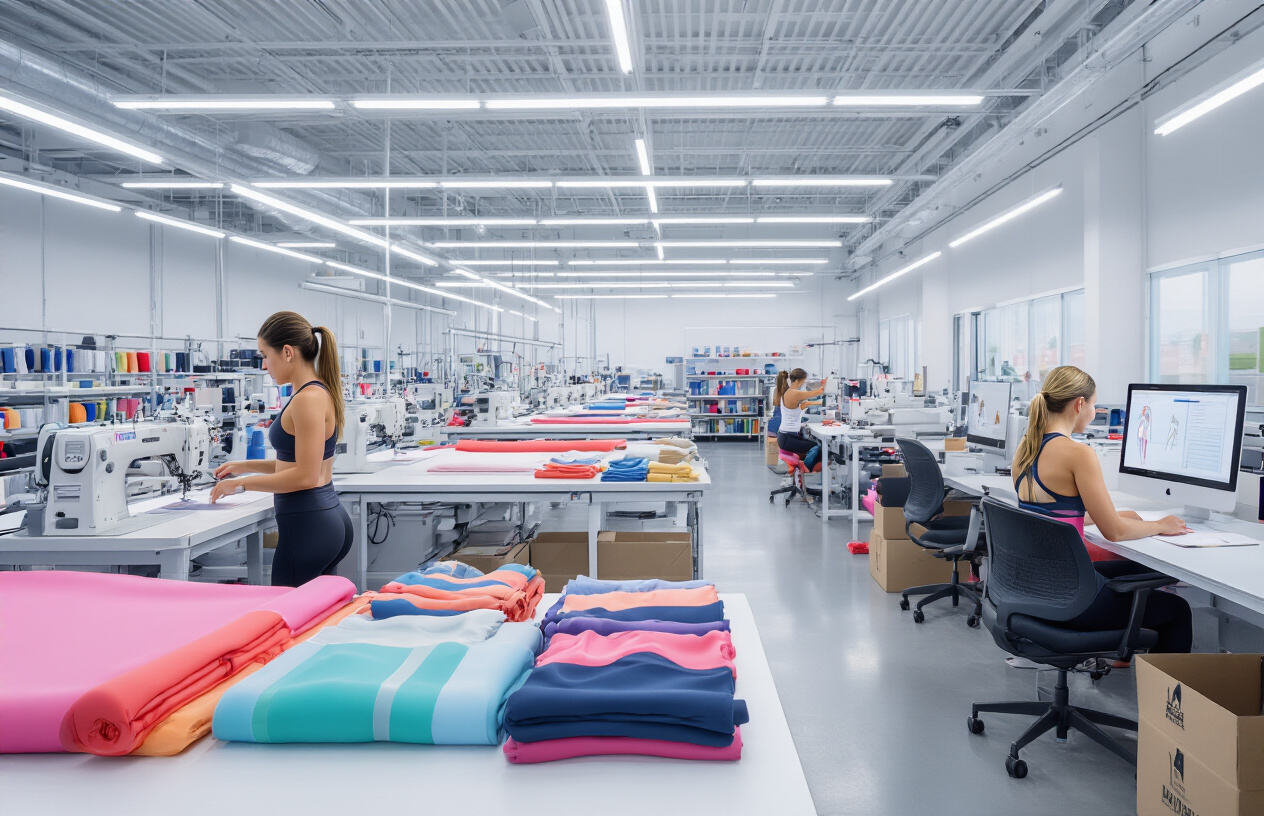
Getting into custom gym wear manufacturing might seem overwhelming, but breaking it down into clear steps makes the journey manageable. From understanding your market and nailing the design details to finding the right manufacturing partner and managing production, each phase builds on the last. The key is taking time to plan properly – rushing through design considerations or skipping prototype testing often leads to costly mistakes down the road.
Your success really comes down to building strong relationships with reliable manufacturers who understand your vision and quality standards. Don't forget that the customer experience extends beyond just the product itself – smart packaging, clear branding, and smooth delivery logistics can set you apart from competitors. Start small with your first custom gym wear project, learn from the process, and scale up as you gain confidence and experience in this exciting market.